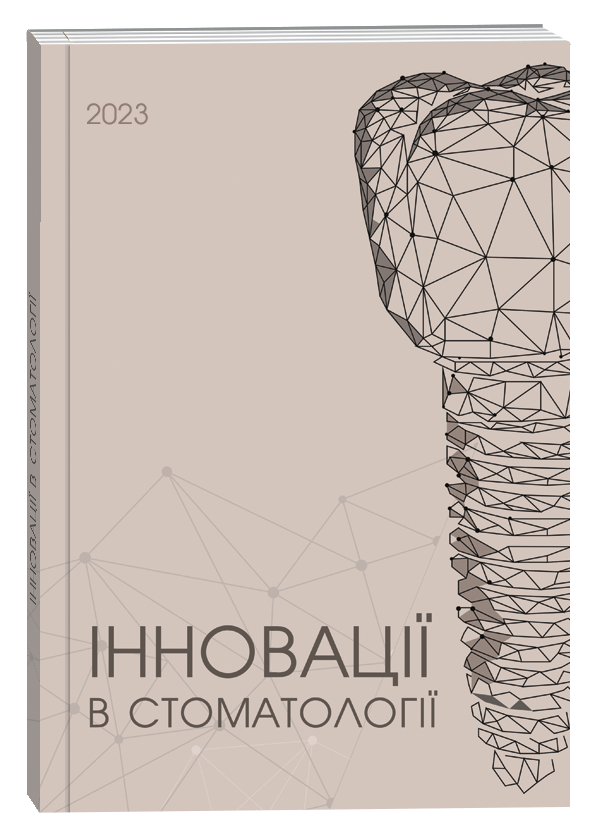ANALYSIS OF RISK FACTORS OF THE DEVELOPMENT AND PROGRESSION OF NON-CARIOUS CERVICAL LEASIONS OF TEETH
DOI:
https://doi.org/10.35220/2523-420X/2025.2.13Keywords:
dietary habits, oral fluid, wedge-shaped defect, erosionAbstract
Purpose of the study. The purpose of the study was to identify and analyze risk factors (RF) for the development and progression of wedge-shaped defect (WSD) and erosion (E) of tooth enamel in young patients. Materials and methods of research. The study involved 272 patients (average age 24.3±6.9 years) who were comprehensively examined by a dentist. Biochemical and chemical indicators of oral fluid (OF), level of personal anxiety were determined in them. The patients filled out a survey/ questionnaire and gave a written informed consent to participate in the study. To assess the strength of the correlation between RF and the studied outcome, the indicator of relative risk (RR) was used for which the limits of the 95% confidence interval (95% CI) were calculated. Scientific novelty. The patient’s age over 25 years and the value of the calculus index are satisfactory while the development of RF, increase in the number and depth of WSD is worse. Their salivation rate less than 0.5 ml/min. increases RR development and depth of lesion by 1.68 and 3.41 times (95% CI [1.04–2.71] and CI [1.23–9.46]), respectively. The value of K/Na molar ratio of OF more than 5.32 (2.83, 95% CI [1.49–5.39]) is RF of the development of WSD of teeth. Taking vitamin C for more than two years and having more than two glasses of Coke and/or Pepsi per day increases RR of their progression. In the majority of cases of RR of the development of E enamel, there are complaints about systemic health, diseases of the digestive and circulatory systems and their combination. The patient’s daily intake of more than two glasses of green tea and two bananas, intensive use of floss, satisfactory and worse value of dental plaque index were determined as RF of the increase in the number of lesions and the active course of E, p<0.05. Conclusions. Timely detection of the development of RF and the increase in the number of WSD and E enamel will positively affect their prevalence, and correction of RF of their progression in depth and active course will increase the effectiveness of treatment and preventive measures.
References
Zabolotna I.I., Bogdanova T.L., Genzytska O.S. A Detailed Analysis of Oral Hygiene Habits of Patients with Cervical Dental Lesions. Cumhuriyet Dental Journal. 2025. No. 28 (2). Р. 157–166. doi: 10.7126/cumudj.1588210.
Nascimento M., Dilbone D., Pereira P., Duarte W.R., Geraldeli S., Delgado A.J. Abfraction lesions: etiology, diagnosis, and treatment options. Clin Cosmet Investig Dent. 2016. No. 8. Р. 79–87. doi: 10.2147/CCIDE.S63465.
Ramsay D.S., Marilynn Rothen M., Scott J., Cunha-Cruz J. Tooth wear and the role of salivary measures in general practice patients. Clin Oral Investig. 2015. No. 19 (1). Р. 85–95. doi: 10.1007/s00784-014-1223-4.
Kolak V., Pešić D., Melih I., Lalović M., Nikitović A., Jakovljević A. Epidemiological investigation of non-carious cervical lesions and possible etiological factors. J Clin Exp Dent. 2018. No. 10 (7). Р. e648–e656. doi: 10.4317/jced.54860.
Nascimento B.L., Vieira A.R., Bezamat M., Ignácio S.A., Souza E.M. Occlusal problems, mental health issues and non-carious cervical lesions. Odontology. 2022. No. 110 (2). Р. 349–355. doi: 10.1007/s10266-021-00658-5.
Milosevic A. Abrasion: A common dental problem revisited. Prim Dent J. 2017. No. 6 (1). Р. 32–36. doi: 10.1177/205016841700600104.
Мельник В.С., Горзов Л.Ф., Когут О.В. Оцінка ризику розвитку карієсу зубів у дітей в сільській місцевості. Клiнiчна стоматологія. 2016. № 1. С. 68–73. doi: 10.11603/2311-9624.2016.1.6156.
Zabolotna I., Bogdanova T., Heiko I., Genzytska O. Correlation between cervical lesions of the teeth and selfreported systemic diseases in young people. Protet Stomatol. 2024. No. 74 (1). P. 3–15. doi: 10.5114/ps/186417.
Заболотна І.І., Комлев А.А, Заболотний О.С. Кореляційний звʼязок хімічного складу емалі та ротової рідини у пацієнтів з інтактними зубами і цервікальною патологією. Вісник Вінницького національного медичного університету. 2022. Т. 26, № 2. С. 220–224. doi: 10.31393/reports-vnmedical-2022-26(2)-08.
Teixeira D.N.R., Zeola L.F., Machado A.C., Gomes RR, Souza PG, Mendes DC, Soares PV. Relationship between noncarious cervical lesions, cervical dentin hypersensitivity, gingival recession, and associated risk factors: а cross-sectional study. J Dent. 2018. No. 76. Р. 93–97. doi:10.1016/j.jdent.2018.06.017.
Alvarez-Arenal A., Alvarez-Menendez L., Gonzalez-Gonzalez I., Jiménez-Castellanos E., Garcia-Gonzalez M., deLlanos-Lanchares H. The Role of Occlusal Factors in the Presence of Noncarious Cervical Lesions in Young People: A Case-Control Study. Oper Dent. 2019. No. 44 (1). Р. E12–E22. doi: 10.2341/18-028-C.
Kanaan M., Brabant A., Eckert G.J., Hara A.T., Carvalho J.C. Non-Biological and Biological Risk Indicators for Tooth Wear Outcomes in Adults. Caries Res. 2022. No. 56 (4). Р. 407–418. doi: 10.1159/000527091.
El Aidi H., Bronkhorst E.M., Huysmans M.C., Truin G.J. Multifactorial analysis of factors associated with the incidence and progression of erosive tooth wear. Caries Res. 2011. No. 45 (3). Р. 303–312. doi: 10.1159/000328671.
Lim S.N., Tay K.J., Li H., Tan K.B.C., Tan K. Prevalence and risk factors of erosive tooth wear among young adults in the Singapore military. Clin Oral Investig. 2022. No. 26 (10). Р. 6129–6137. doi:10.1007/s00784-022-04562-2.
Alvarez-Arenal A., Alvarez-Menendez L., Gonzalez-Gonzalez I., Alvarez-Riesgo J.A., Brizuela-Velasco A., deLlanos-Lanchares H. Non-carious cervical lesions and risk factors: A case-control study. J Oral Rehabil. 2019. No. 46 (1). Р. 65–75. doi: 10.1111/joor.12721.
Femiano F., Femiano R., Femiano L., Festa V.M., Rullo R., Perillo L. Noncarious cervical lesions: correlation between abfraction and wear facets in permanent dentition. Open Journal of Stomatology. 2015. No. 5. Р. 152–157. doi: 10.4236/ojst.2015.56021.
Demarco F.F., Cademartori M.G., Hartwig A.D., Lund R.G., Azevedo M.S., Horta B.L., Corrêa M.B., Huysmans M.D.N.J.M. Non-carious cervical lesions (NCCLs) and associated factors: A multilevel analysis in a cohort study in southern Brazil. J Clin Periodontol. 2022. No. 49 (1). Р. 48–58. doi: 10.1111/jcpe.13549.








